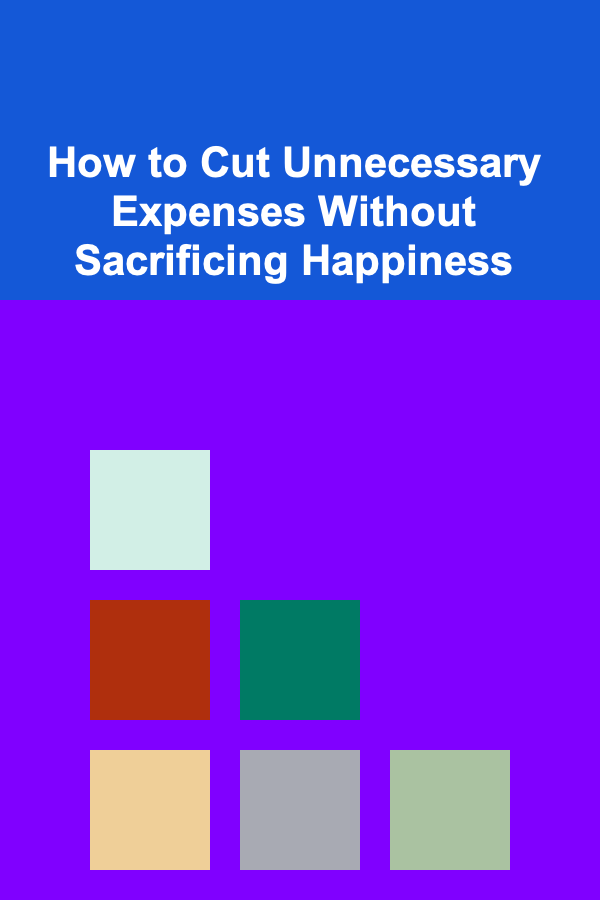
How to Plan Your Day with a Digital Daily Planner App
ebook include PDF & Audio bundle (Micro Guide)
$12.99$5.99
Limited Time Offer! Order within the next:
Not available at this time

In today's fast-paced world, staying organized and managing your time effectively is more crucial than ever. With numerous tasks to juggle, from work deadlines to personal commitments, having a reliable method to plan and track your daily activities is essential for boosting productivity and maintaining a healthy work-life balance. Digital daily planners have emerged as a powerful tool to help individuals manage their time efficiently.
A digital daily planner app offers more than just a space to jot down tasks---it allows you to optimize your time, track progress, and maintain a clear overview of your day. But how exactly can you use a digital planner to structure your day effectively? In this article, we'll explore how you can leverage these apps to streamline your day, boost productivity, and achieve your goals.
Understanding the Benefits of a Digital Daily Planner
Before diving into how to plan your day using a digital planner app, it's important to first understand why these tools have become so popular. A digital daily planner app provides several advantages over traditional paper planners, including:
- Accessibility: You can access your planner from any device, including your phone, tablet, or computer. This means you're never far from your schedule, even when you're on the go.
- Customization: Many digital planners offer various templates, features, and integrations that allow you to tailor your planner to your unique needs.
- Real-time updates: If your plans change, you can quickly update your schedule. This helps to avoid the confusion and inconvenience that comes with erasing or crossing out things in a physical planner.
- Task reminders: Digital planners come with built-in reminders and alerts that help ensure you don't miss important tasks or appointments.
- Sustainability: Unlike paper planners, digital planners do not waste paper, making them an eco-friendly choice.
By utilizing these benefits, digital daily planner apps can help reduce stress, improve organization, and enhance your overall productivity.
Choosing the Right Digital Planner App
Not all digital planner apps are created equal. There are a plethora of options available, each with its own set of features and capabilities. The key to successfully using a digital planner is selecting the right one for your needs. When evaluating planner apps, consider the following factors:
Features to Look For:
- Task management: The ability to add, organize, and prioritize tasks is essential for any planner app. Look for apps that allow you to create multiple to-do lists, set deadlines, and categorize tasks by priority or project.
- Calendar integration: A good digital planner app should integrate with your calendar, allowing you to schedule appointments and meetings in real time.
- Customizability: The ability to customize your planner with colors, themes, and layouts can help make the app more user-friendly and personalized to your preferences.
- Task reminders: Automated reminders and notifications are critical for ensuring you never miss an important task or event.
- Collaboration tools: Some apps allow you to share tasks with others or delegate responsibilities, which is particularly useful for team projects or family planning.
- Cross-device syncing: Choose an app that syncs seamlessly across multiple devices so that you can access your planner wherever you are.
Popular Digital Planner Apps:
- Todoist: Todoist is known for its powerful task management features and intuitive interface. It allows you to break tasks down into subtasks, assign priorities, and set recurring tasks.
- Google Calendar: Google Calendar is a simple yet highly effective tool for managing your schedule. It integrates with other Google services and allows you to set reminders, events, and appointments.
- Notion: Notion is an all-in-one workspace that can serve as both a planner and a knowledge management system. It offers incredible flexibility, allowing you to create personalized templates for daily, weekly, or monthly planning.
- Trello: Trello uses boards and cards to organize tasks visually. It's a great choice if you prefer to see your tasks in a kanban-style format, making it easy to track progress and prioritize work.
- Microsoft To Do: A task management app that allows you to create to-do lists, set deadlines, and integrate with Microsoft 365 tools for a streamlined experience.
Take the time to explore these apps and find one that aligns with your specific needs, work style, and preferences.
Setting Up Your Digital Daily Planner
Once you've selected the right digital planner app, it's time to set it up. Proper setup ensures that you can make the most out of the app's features and start your day with clear organization. Here's how you can get started:
Step 1: Customize Your Planner
Start by personalizing the app to suit your needs. Most digital planners offer customization options such as:
- Choosing a theme or layout: Pick a design that appeals to you and is easy on the eyes. Having a well-organized and visually pleasing interface can make planning less of a chore.
- Setting your time zone and work hours: Make sure your planner reflects your actual working hours, especially if you're scheduling meetings or tasks that need to be completed during certain times of the day.
- Setting default notifications: Customize reminder settings for each task, whether you prefer daily or weekly alerts, or need a reminder at a specific time.
Step 2: Input Your Recurring Tasks and Events
Many aspects of your day are predictable, such as work meetings, gym sessions, or daily chores. Instead of adding these tasks manually every day, input them as recurring tasks. For example:
- Work hours: Set your daily work schedule, including breaks, to avoid over-scheduling.
- Meetings and appointments: Input any standing meetings, appointments, or events that occur regularly.
- Daily habits: You can also use your planner to track daily habits like drinking water, exercising, or meditating.
By automating these recurring tasks, you free up space for more important, time-sensitive activities.
Step 3: Add Tasks for the Day
Now that your planner is set up, it's time to input the tasks for the day. Begin by writing down all the tasks you need to accomplish. This could include work tasks, errands, or personal activities. The digital planner app allows you to:
- Create multiple task lists: You can categorize tasks into different lists, such as "Work," "Personal," "Shopping," or "Urgent."
- Prioritize tasks: Mark tasks with different priority levels (low, medium, high) or use labels to distinguish between urgent, important, and optional tasks.
- Break tasks into subtasks: If you have larger projects or tasks, break them down into manageable subtasks that you can complete step by step.
Organizing tasks in this manner helps reduce overwhelm and ensures that you can focus on what needs to be done first.
Step 4: Set Deadlines and Reminders
For each task or event, set deadlines and reminders to help you stay on track. Most apps allow you to set specific dates and times for when you want to be reminded. Consider these tips:
- Set a realistic deadline: Make sure the deadline is achievable given your other commitments. Avoid setting overly tight deadlines that can lead to unnecessary stress.
- Set multiple reminders: For important tasks, set multiple reminders, such as one a day before and another an hour before. This ensures you don't forget.
Step 5: Add Notes or Attachments
For more complex tasks, consider adding notes or attaching relevant files directly to the task. For example, if you have a presentation to prepare, you can attach your PowerPoint slides, notes, or research documents to the task so that everything you need is in one place.
Managing Your Day: How to Use Your Digital Planner Effectively
Now that your planner is set up, let's look at how to manage your day effectively using it. Here are some tips to make the most out of your digital daily planner:
Tip 1: Plan Your Day the Night Before
While it's tempting to start planning first thing in the morning, it's often more efficient to plan the night before. Before going to bed, take a few minutes to review your tasks for the next day and prioritize them. This gives you a head start and allows you to wake up with a clear plan.
Tip 2: Time Block Your Day
Time blocking is a productivity technique where you allocate specific time blocks for different tasks or activities. For example, you might allocate:
- 9:00 AM - 11:00 AM: Work on project A
- 11:00 AM - 12:00 PM: Respond to emails
- 1:00 PM - 2:00 PM: Attend meeting with client
By grouping similar tasks together and allocating dedicated time for each, you prevent multitasking and create more focus throughout the day.
Tip 3: Use the Pomodoro Technique
The Pomodoro Technique involves working in short bursts---typically 25 minutes---followed by a 5-minute break. After completing four "Pomodoros," you take a longer break. Many digital planner apps integrate this technique, allowing you to easily track your sessions and breaks.
Tip 4: Track Progress Throughout the Day
One of the key advantages of using a digital planner is that you can track your progress in real time. As you complete tasks, mark them as done. This helps you stay motivated and provides a sense of accomplishment.
Tip 5: Adjust as Needed
Plans often change. If something unexpected comes up or you need more time for a task, your digital planner allows for easy adjustments. Re-prioritize tasks as needed, and make sure your planner reflects the updated reality of your day.
Reviewing and Reflecting at the End of the Day
At the end of the day, take a moment to review your planner and reflect on your progress. Here are a few things to consider:
- Review completed tasks: Celebrate what you've accomplished and acknowledge your hard work.
- Re-assess unfinished tasks: If you didn't complete certain tasks, move them to the next day and adjust your schedule accordingly.
- Reflect on your productivity: Consider what worked well and what didn't. This will help you optimize your planning process in the future.
By taking time to reflect, you'll continuously improve how you use your planner and fine-tune your daily routines.
Conclusion
A digital daily planner app is a powerful tool for managing your day, increasing productivity, and staying organized. By choosing the right app, setting it up thoughtfully, and using it consistently, you can take control of your schedule and ensure that you stay on track with your goals. Whether you're managing work tasks, personal commitments, or both, a well-organized digital planner can be the key to a more efficient and stress-free day.
Incorporate these strategies into your daily routine, and you'll soon see how a digital planner can transform your time management and help you achieve more with less effort. Happy planning!

How to Cut Unnecessary Expenses Without Sacrificing Happiness
Read More
How to Stage a Home with Minimal Time and Effort
Read More
How to Start Investing in Peer-to-Peer Lending Platforms
Read More
How To Understand the Basics of Black Holes
Read More
How To Transition to a Fully Remote Career
Read More
How To Implement SEO for Your Business Website: A Comprehensive Guide
Read MoreOther Products

How to Cut Unnecessary Expenses Without Sacrificing Happiness
Read More
How to Stage a Home with Minimal Time and Effort
Read More
How to Start Investing in Peer-to-Peer Lending Platforms
Read More
How To Understand the Basics of Black Holes
Read More
How To Transition to a Fully Remote Career
Read More